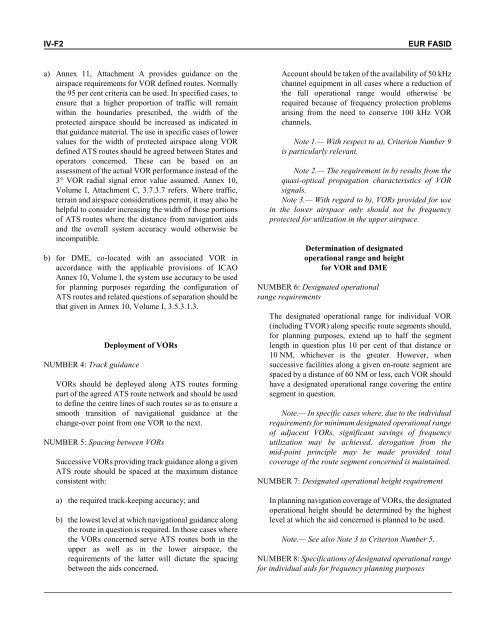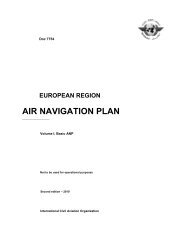7754 Vol 2 Flyleaf - ICAO Public Maps
7754 Vol 2 Flyleaf - ICAO Public Maps
7754 Vol 2 Flyleaf - ICAO Public Maps
Create successful ePaper yourself
Turn your PDF publications into a flip-book with our unique Google optimized e-Paper software.
IV-F2<br />
EUR FASID<br />
a) Annex 11, Attachment A provides guidance on the<br />
airspace requirements for VOR defined routes. Normally<br />
the 95 per cent criteria can be used. In specified cases, to<br />
ensure that a higher proportion of traffic will remain<br />
within the boundaries prescribed, the width of the<br />
protected airspace should be increased as indicated in<br />
that guidance material. The use in specific cases of lower<br />
values for the width of protected airspace along VOR<br />
defined ATS routes should be agreed between States and<br />
operators concerned. These can be based on an<br />
assessment of the actual VOR performance instead of the<br />
3 VOR radial signal error value assumed. Annex 10,<br />
<strong>Vol</strong>ume I, Attachment C, 3.7.3.7 refers. Where traffic,<br />
terrain and airspace considerations permit, it may also be<br />
helpful to consider increasing the width of those portions<br />
of ATS routes where the distance from navigation aids<br />
and the overall system accuracy would otherwise be<br />
incompatible.<br />
b) for DME, co-located with an associated VOR in<br />
accordance with the applicable provisions of <strong>ICAO</strong><br />
Annex 10, <strong>Vol</strong>ume I, the system use accuracy to be used<br />
for planning purposes regarding the configuration of<br />
ATS routes and related questions of separation should be<br />
that given in Annex 10, <strong>Vol</strong>ume I, 3.5.3.1.3.<br />
NUMBER 4: Track guidance<br />
Deployment of VORs<br />
VORs should be deployed along ATS routes forming<br />
part of the agreed ATS route network and should be used<br />
to define the centre lines of such routes so as to ensure a<br />
smooth transition of navigational guidance at the<br />
change-over point from one VOR to the next.<br />
NUMBER 5: Spacing between VORs<br />
Successive VORs providing track guidance along a given<br />
ATS route should be spaced at the maximum distance<br />
consistent with:<br />
a) the required track-keeping accuracy; and<br />
b) the lowest level at which navigational guidance along<br />
the route in question is required. In those cases where<br />
the VORs concerned serve ATS routes both in the<br />
upper as well as in the lower airspace, the<br />
requirements of the latter will dictate the spacing<br />
between the aids concerned.<br />
Account should be taken of the availability of 50 kHz<br />
channel equipment in all cases where a reduction of<br />
the full operational range would otherwise be<br />
required because of frequency protection problems<br />
arising from the need to conserve 100 kHz VOR<br />
channels.<br />
Note 1.— With respect to a), Criterion Number 9<br />
is particularly relevant.<br />
Note 2.— The requirement in b) results from the<br />
quasi-optical propagation characteristics of VOR<br />
signals.<br />
Note 3.— With regard to b), VORs provided for use<br />
in the lower airspace only should not be frequency<br />
protected for utilization in the upper airspace.<br />
Determination of designated<br />
operational range and height<br />
for VOR and DME<br />
NUMBER 6: Designated operational<br />
range requirements<br />
The designated operational range for individual VOR<br />
(including TVOR) along specific route segments should,<br />
for planning purposes, extend up to half the segment<br />
length in question plus 10 per cent of that distance or<br />
10 NM, whichever is the greater. However, when<br />
successive facilities along a given en-route segment are<br />
spaced by a distance of 60 NM or less, each VOR should<br />
have a designated operational range covering the entire<br />
segment in question.<br />
Note.— In specific cases where, due to the individual<br />
requirements for minimum designated operational range<br />
of adjacent VORs, significant savings of frequency<br />
utilization may be achieved, derogation from the<br />
mid-point principle may be made provided total<br />
coverage of the route segment concerned is maintained.<br />
NUMBER 7: Designated operational height requirement<br />
In planning navigation coverage of VORs, the designated<br />
operational height should be determined by the highest<br />
level at which the aid concerned is planned to be used.<br />
Note.— See also Note 3 to Criterion Number 5.<br />
NUMBER 8: Specifications of designated operational range<br />
for individual aids for frequency planning purposes














